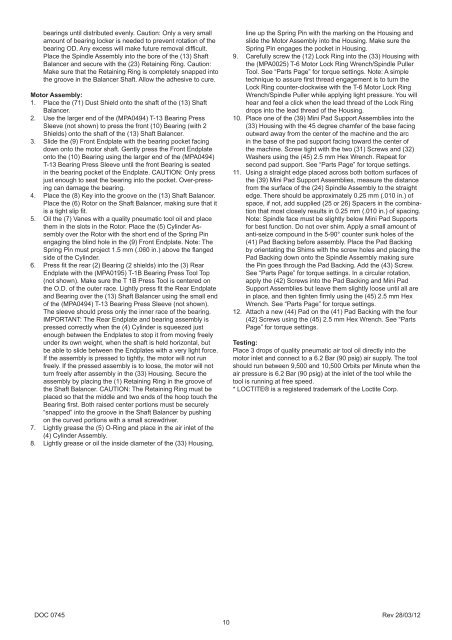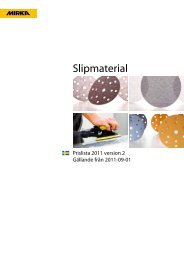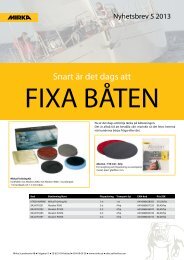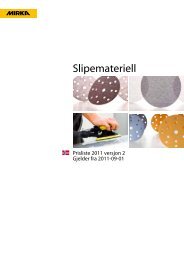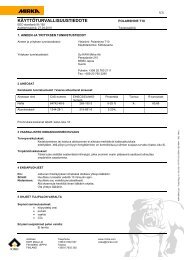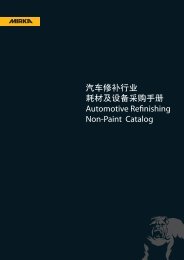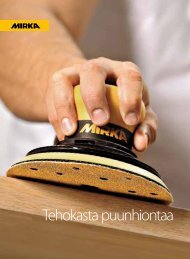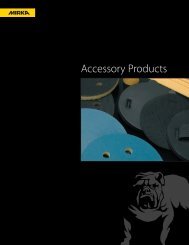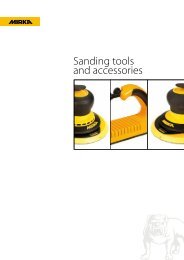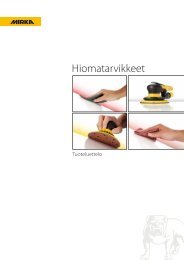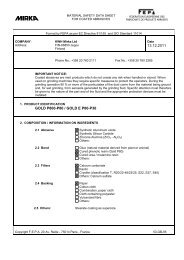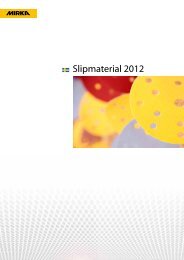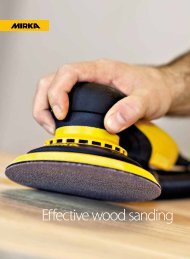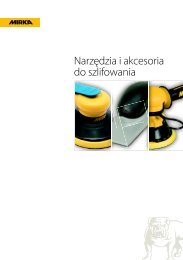OS 75x100 mm.pdfTélécharger - KWH Mirka Ltd
OS 75x100 mm.pdfTélécharger - KWH Mirka Ltd
OS 75x100 mm.pdfTélécharger - KWH Mirka Ltd
You also want an ePaper? Increase the reach of your titles
YUMPU automatically turns print PDFs into web optimized ePapers that Google loves.
earings until distributed evenly. Caution: Only a very small<br />
amount of bearing locker is needed to prevent rotation of the<br />
bearing OD. Any excess will make future removal difficult.<br />
Place the Spindle Assembly into the bore of the (13) Shaft<br />
Balancer and secure with the (23) Retaining Ring. Caution:<br />
Make sure that the Retaining Ring is completely snapped into<br />
the groove in the Balancer Shaft. Allow the adhesive to cure.<br />
Motor Assembly:<br />
1. Place the (71) Dust Shield onto the shaft of the (13) Shaft<br />
Balancer.<br />
2. Use the larger end of the (MPA0494) T-13 Bearing Press<br />
Sleeve (not shown) to press the front (10) Bearing (with 2<br />
Shields) onto the shaft of the (13) Shaft Balancer.<br />
3. Slide the (9) Front Endplate with the bearing pocket facing<br />
down onto the motor shaft. Gently press the Front Endplate<br />
onto the (10) Bearing using the larger end of the (MPA0494)<br />
T-13 Bearing Press Sleeve until the front Bearing is seated<br />
in the bearing pocket of the Endplate. CAUTION: Only press<br />
just enough to seat the bearing into the pocket. Over-pressing<br />
can damage the bearing.<br />
4. Place the (8) Key into the groove on the (13) Shaft Balancer.<br />
Place the (6) Rotor on the Shaft Balancer, making sure that it<br />
is a tight slip fit.<br />
5. Oil the (7) Vanes with a quality pneumatic tool oil and place<br />
them in the slots in the Rotor. Place the (5) Cylinder Assembly<br />
over the Rotor with the short end of the Spring Pin<br />
engaging the blind hole in the (9) Front Endplate. Note: The<br />
Spring Pin must project 1.5 <strong>mm</strong> (.060 in.) above the flanged<br />
side of the Cylinder.<br />
6. Press fit the rear (2) Bearing (2 shields) into the (3) Rear<br />
Endplate with the (MPA0195) T-1B Bearing Press Tool Top<br />
(not shown). Make sure the T 1B Press Tool is centered on<br />
the O.D. of the outer race. Lightly press fit the Rear Endplate<br />
and Bearing over the (13) Shaft Balancer using the small end<br />
of the (MPA0494) T-13 Bearing Press Sleeve (not shown).<br />
The sleeve should press only the inner race of the bearing.<br />
IMPORTANT: The Rear Endplate and bearing assembly is<br />
pressed correctly when the (4) Cylinder is squeezed just<br />
enough between the Endplates to stop it from moving freely<br />
under its own weight, when the shaft is held horizontal, but<br />
be able to slide between the Endplates with a very light force.<br />
If the assembly is pressed to tightly, the motor will not run<br />
freely. If the pressed assembly is to loose, the motor will not<br />
turn freely after assembly in the (33) Housing. Secure the<br />
assembly by placing the (1) Retaining Ring in the groove of<br />
the Shaft Balancer. CAUTION: The Retaining Ring must be<br />
placed so that the middle and two ends of the hoop touch the<br />
Bearing first. Both raised center portions must be securely<br />
“snapped” into the groove in the Shaft Balancer by pushing<br />
on the curved portions with a small screwdriver.<br />
7. Lightly grease the (5) O-Ring and place in the air inlet of the<br />
(4) Cylinder Assembly.<br />
8. Lightly grease or oil the inside diameter of the (33) Housing,<br />
line up the Spring Pin with the marking on the Housing and<br />
slide the Motor Assembly into the Housing. Make sure the<br />
Spring Pin engages the pocket in Housing.<br />
9. Carefully screw the (12) Lock Ring into the (33) Housing with<br />
the (MPA0025) T-6 Motor Lock Ring Wrench/Spindle Puller<br />
Tool. See “Parts Page” for torque settings. Note: A simple<br />
technique to assure first thread engagement is to turn the<br />
Lock Ring counter-clockwise with the T-6 Motor Lock Ring<br />
Wrench/Spindle Puller while applying light pressure. You will<br />
hear and feel a click when the lead thread of the Lock Ring<br />
drops into the lead thread of the Housing.<br />
10. Place one of the (39) Mini Pad Support Assemblies into the<br />
(33) Housing with the 45 degree chamfer of the base facing<br />
outward away from the center of the machine and the arc<br />
in the base of the pad support facing toward the center of<br />
the machine. Screw tight with the two (31) Screws and (32)<br />
Washers using the (45) 2.5 <strong>mm</strong> Hex Wrench. Repeat for<br />
second pad support. See “Parts Page” for torque settings.<br />
11. Using a straight edge placed across both bottom surfaces of<br />
the (39) Mini Pad Support Assemblies, measure the distance<br />
from the surface of the (24) Spindle Assembly to the straight<br />
edge. There should be approximately 0.25 <strong>mm</strong> (.010 in.) of<br />
space, if not, add supplied (25 or 26) Spacers in the combination<br />
that most closely results in 0.25 <strong>mm</strong> (.010 in.) of spacing.<br />
Note: Spindle face must be slightly below Mini Pad Supports<br />
for best function. Do not over shim. Apply a small amount of<br />
anti-seize compound in the 5-90° counter sunk holes of the<br />
(41) Pad Backing before assembly. Place the Pad Backing<br />
by orientating the Shims with the screw holes and placing the<br />
Pad Backing down onto the Spindle Assembly making sure<br />
the Pin goes through the Pad Backing. Add the (43) Screw.<br />
See “Parts Page” for torque settings. In a circular rotation,<br />
apply the (42) Screws into the Pad Backing and Mini Pad<br />
Support Assemblies but leave them slightly loose until all are<br />
in place, and then tighten firmly using the (45) 2.5 <strong>mm</strong> Hex<br />
Wrench. See “Parts Page” for torque settings.<br />
12. Attach a new (44) Pad on the (41) Pad Backing with the four<br />
(42) Screws using the (45) 2.5 <strong>mm</strong> Hex Wrench. See “Parts<br />
Page” for torque settings.<br />
Testing:<br />
Place 3 drops of quality pneumatic air tool oil directly into the<br />
motor inlet and connect to a 6.2 Bar (90 psig) air supply. The tool<br />
should run between 9,500 and 10,500 Orbits per Minute when the<br />
air pressure is 6.2 Bar (90 psig) at the inlet of the tool while the<br />
tool is running at free speed.<br />
* LOCTITE® is a registered trademark of the Loctite Corp.<br />
DOC 0745<br />
10<br />
Rev 28/03/12


